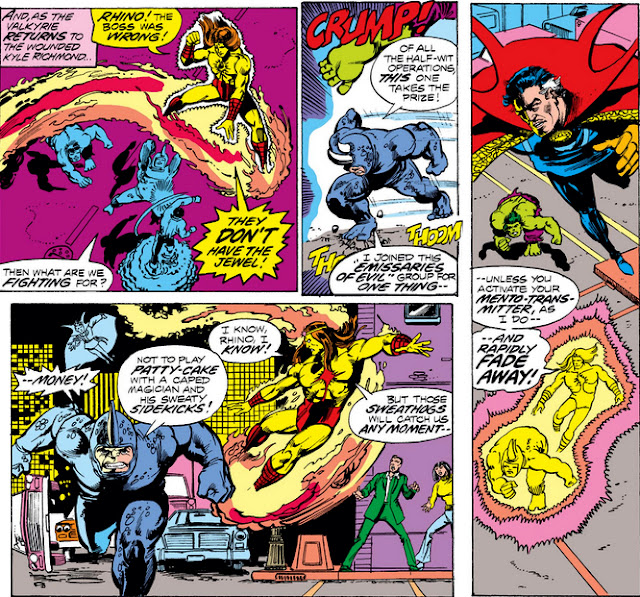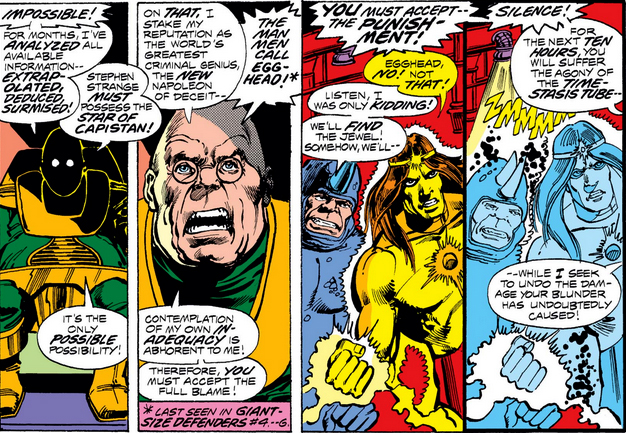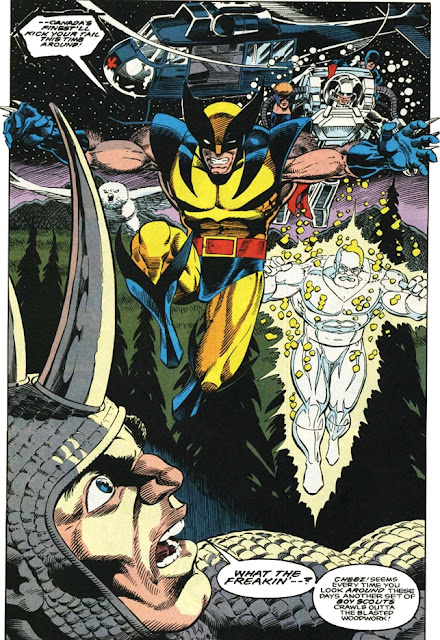While clearly alliterative, the name of the group of villains who comprised the Emissaries of Evil seemed to come up short--after all, what villain would want to be regarded as an "emissary"? Are they an evildoer, or a messenger? Diplomatic, rather than deadly. "Greetings... we're here to bring you the evil that we harbor toward you" or, closer to the mark, something that indicates they've been sent by someone even more evil: "We come bearing a message from our master: 'Die!' " Yet in comics, alliteration goes a long way when you add an exclamation point--and those who would join the Emissaries club took their role seriously, even though I doubt the "Emissaries of Evil" was a name they could use as a form of intimidation toward those they went after, or even to strike fear into their targets. The Masters of Evil grabbed the really good name in those respects.
There was only one grouping of Emissaries who formed up and operated on their own volition, and that turned out to be the original team (though I'm probably being generous with that noun) from 1967, with Electro getting first billing as the one who gathered them together:
As was the case with the the Sinister Six in the first Amazing Spider-Man Annual, Daredevil would initially battle the Emissaries one by one; but going the ASM Annual one better, the DD issue, as we've seen, would provide a finale where Daredevil faced and battled the entire group. But under what circumstances did other groupings of evil Emissaries stick with that dopey name assemble over the years?
It took nine years for someone to bring that not-so-hallowed name out of mothballs after Electro and his crew were carted off to jail. But who would instigate the concept anew? If there's a criminal mastermind who's often made use of super-powered hirelings to do his bidding (as he did the Masters), it would be Elihas Starr, aka Egghead, who gathered three such men to conduct an all-out attack on the Defenders--in part as revenge for interfering with his personal vendetta against his niece, Trish, but also as the means to gain for himself the largest ruby in the world, the Star of Capistan. The initial attack is aborted when the ruby proves to be elusive--and while Egghead isn't pleased, we readers are privileged to flip the pages and take in some excellent art by Keith Giffen and Klaus Janson.
But who was Egghead's third Emissary? None other than, of all people, the Cobalt Man, whom Egghead had brainwashed as well as armed to detonate in an atomic holocaust which would destroy the Defenders (and I'm guessing a good deal more).
We're all still here, so obviously Egghead's scheme didn't pan out--and there were also complications involving the Star of Capistan, which the PPC has covered previously.
From here we fast-forward sixteen years to find Egghead once again making use of Solarr and the Rhino while adding the Porcupine, the Eel, the Swordsman, and Power Man. Technically, we can't say this is a new assemblage of the Emissaries of Evil, since Egghead has apparently downgraded the name and now regards them as his "employed emissaries"--but we can take a little license nonetheless, and join them in Canada where they make the leap to being potential international terrorists who would eventually face budding members of Alpha Flight.
Next up, however, we leave Egghead behind and jump ahead six years to find that the Kingpin has gathered his own Emissaries to help secure his operations in Paris. Suiting up this time are Le Concierge, Synapse--and a founding member, the Stilt-Man, who is neutralized by Synapse under the Kingpin's orders for refusing to undertake an assignment to murder an innocent woman (Dr. Claudia DuBois) who had treated a dying SHIELD agent sanctioned by the Kingpin. After DuBois is rescued by a man named Laurent LeVasseur (in actuality Daredevil, unknowingly working undercover for SHIELD), DD eventually crosses paths with one of the Emissaries who is out to recruit him.
Once this storyline has run its course, it's clear that the "Emissaries of Evil" moniker has become available to be recycled from time to time, presumably whenever a writer feels like dusting it off for reuse with either familiar faces or fresh ones. I frankly can't see men like the Matador, the Leap-Frog, the Gladiator, or any former Emissaries feeling such pride in the name as to make an effort to reform their respective groups, but you never know--nostalgia on the part of a writer can sometimes be more compelling than any paycheck Egghead or the Kingpin might hand out.














"Any attempts to stop me by the Avengers or the Fantastic Four -- or the Canadian authorities..."
ReplyDeleteEvery super-villain's worst nightmare - the Canadian authorities!
Never mind the Avengers or FF, what if Justin Trudeau sends in the Mounties?
-sean
Well, sean, he did qualify it somewhat: "...or the Canadian authorities for that matter..." so as not to lessen their importance. (Though I don't know why he bothered. Since he made a point of stressing that he's mainly addressing the U.S., he's already rubbed the Canadians the wrong way!)
ReplyDeleteThe Emissaries of Evil is clearly one of Marvel's less interesting villain groups. The name just doesn't have the appeal of teams like the Frightful Four, Lethal Legion, Masters of Evil, or Sinister Six.
ReplyDeleteIts original line up has a lot of lame villains like Matador, Leapfrog, and Stilt-Man. Most of DD's early villains are just not good, and was an early indicator of what Stan Lee was capable of when not paired with people like Kirby and Ditko (or even Heck).
And there is no way Electro should ever have been a DD villain. He's just too powerful, and DD's own power and skill set is not suited for defeating him. I'm sure there's one really good story could be done with the two, but not any repeat basis. Lee unfortunately would repurpose a variety of villains from their original heroes to others, and they just would not work out.
So the team just fails as an attempt to create a group of DD villains that could eventually work together again. The Sinister Six was not used again for decades, but eventually when they came back it could work because Spidey has one of the best rogue's galleries in comics.
I think the team works OK as a group of villain Egghead uses, but the name is clearly just taken because it already exists and is alliterative to Egghead. Unfortunately Egghead is a fairly lame villain himself so the team never earns a cachet of its own. It's just one of those names that gets used when a writer wants some generic villains doing generic crimes.
If Lee had created better villains for DD (or used them better, as I feel not all of their concepts were inherently lame just the implementation of them) and brought in more appropriate villains instead (why not the Scarecrow who would make a much better DD villain than an Iron Man villain, or just the Cobra without Hyde, or the Eel instead of Electro, or the Enforcers (yeah I know Lee brought in the Ox to join another team, but really?), then he could have created a much better "best villain team up" for DD that could have had staying power.
Lee created a great hero, and the original supporting cast was stellar, but his actual stories and plots was distinctly underwhelming.
Chris
I love the David Kraft Defenders. That title was fun to read. The guy could do pathos and comedy with equal skill, even in the same story.
ReplyDeleteI agree with Chris that Electro was an odd villain for Daredevil. It's like the guy started out as a Spider-Man foe and then got demoted, just like Mr. Hyde got demoted. The problem, which was also pointed out, is that Daredevil had a light bench when it came to a rogue's gallery. There were a lotta low cards in that hand. They hadda beef it up, at least a little.
Stilt-Man couldn't get demoted, he started at the bottom and actually moved up. Sort of. He lasted a good three or four minutes with Thor, and that ain't small beans.
The more recent stuff reviewed here is new to me, and that's always a treat. I'm surprised Egghead is not dead anymore, but you'd think I would know better by now. Anyway, I love a good supervillain team-up, and I don't much care how goofy the line-up is. I say, go ahead and bring on the goof.
M.P.
Vice-Chairman and Director of Community Outreach, Stilt-Man Appreciation Society
Stilt-Man ... started at the bottom and actually moved up. See what you did there, M.P.? I couldn't help but crack a smile. :D
ReplyDeleteDaredevil has generally proven to be a difficult "fit" when it comes to pairing him up with opponents. They often tend to be a bizarre as Spider-Man's in order to provide an eye-catching cover on the comics rack--yet Spider-Man has always had the edge in his super-strength and powers, whereas DD is mostly a guy who works out, relying on his trained agility, quick thinking, and "radar sense" (as the Mole Man does) to navigate his way through a fight. As a result, only one of them can realistically be moved up to the big leagues when the situation calls for it, and that includes the villain du jour. It was arguably a tough job for Lee to make Daredevil sellable--frankly I'm surprised readers stuck with it as long as they did in those early days.
Making a Daredevil rogues gallery, in theory, shouldn't be any tougher than making one for Batman. Your description of DD's non-powered abilities matches that of the Dark Knight pretty well. If a tubby little villain called "the Penguin"(!?!) with a bird obsession could eventually join Batman's legendary rogues gallery, one could say the Matador had the same potential.
ReplyDeleteBut, as this comment thread seems to be flowing, it's all down to the subsequent writing effort and skills.
M.P. - Like yourself, villain demotion/deflation frequently caught my eye, too - back in the day. It often seems to happen when a superhero faces a villain 'double act'. For example, the Gladiator was a villain worthy of Iron Man. Yet, later, as part of a double act, with the Beetle, the Gladiator was easily beaten by Daredevil (DD # 140), who has no super strength whatsoever. Likewise, the Lizard was one of Spidey's greatest foes, being significantly stronger than web-head, yet, in Amazing Spider-man # 166, Spidey didn't just beat, but easily beat, the Lizard, along with Stegron (who, admittedly were at each other's throats). Thirdly, originally, the Constrictor was a villain worthy of battling the Hulk, single-handedly, yet, when part of a double act with Sabretooth, Constrictor was easily beaten by Power Man & Iron Fist (PM & IF # 66). I think the lesson for villains may be: "Too many cooks spoil the broth" ! M.P. - very interesting discussion, anyway - I enjoyed reading it!
ReplyDeletePhillip